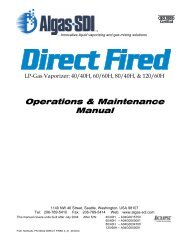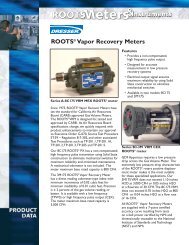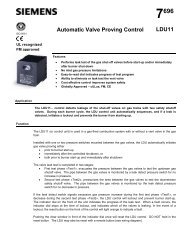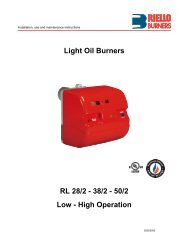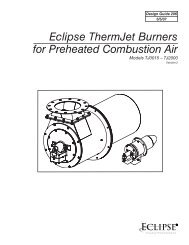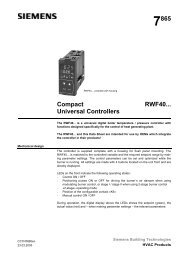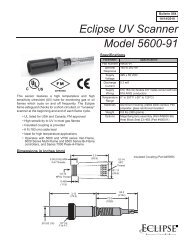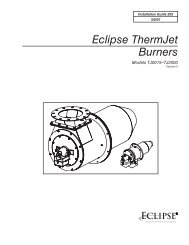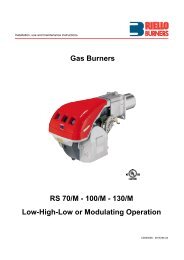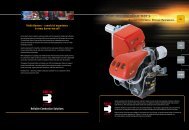Feb. 05 - Power Equipment Company
Feb. 05 - Power Equipment Company
Feb. 05 - Power Equipment Company
Create successful ePaper yourself
Turn your PDF publications into a flip-book with our unique Google optimized e-Paper software.
ECLIPSE INFORMATION GUIDE<br />
INCINI-CONE BURNER<br />
SERIES "IC"<br />
Info 420<br />
2/10/<strong>05</strong><br />
WARNING<br />
The burners covered in this Guide are designed to mix<br />
fuel with air and burn the resulting mixture. All fuel burning<br />
devices can produce explosions and fires when improperly<br />
applied, installed, adjusted, controlled, or maintained.<br />
This Guide provides information for using these<br />
burners for their limited design purpose.<br />
Do not deviate from any instructions or application limits<br />
in this Guide without written advice from the Eclipse Combustion<br />
Division in Rockford, Illinois. Read this entire<br />
Guide before attempting to light burners. If you do not<br />
understand any part of the information in this Guide, contact<br />
your local Eclipse representative or Eclipse Combustion<br />
before proceeding further.<br />
Protection from the elements must be provided from the<br />
time the Incini-Cone burner leaves the Eclipse factory.<br />
Do not store outside. Rain, snow or temperature extremes<br />
may damage the burner.<br />
All maintenance and trouble shooting on Incini-Cone<br />
burners should be performed by people with good mechanical<br />
aptitude and experience with combustion equipment.<br />
Important Notices About Safe Burner Operation<br />
l. Store the burner inside. Exposure to the elements can<br />
damage the burner.<br />
2. Adjustment, maintenance, and troubleshooting of the<br />
mechanical parts of this unit should be done by<br />
people with good mechanical aptitude and experience<br />
with combustion equipment.<br />
3. Order replacement parts from Eclipse Combustion<br />
only. Customer-supplied valves or switches must<br />
have UL, FM, CSA, and/or CGA approval where applicable.<br />
4. The best safety precaution is an alert and competent<br />
operator. Thoroughly instruct new operators so they<br />
demonstrate an adequate understanding of the equipment<br />
and its operation. Regular retraining must be<br />
scheduled to maintain a high degree of proficiency.<br />
The operator must have easy access to this Information<br />
Guide at all times.<br />
1.0 Applications<br />
Eclipse Incini-Cone Burners are gas burners designed<br />
primarily for mounting in exhaust ducts where all of the<br />
combustion air flows through and by the burner.<br />
These burners provide clean combustion throughout<br />
a fuel turndown range of 26:1. They are well suited to<br />
applications requiring a clean, high rate of destruction<br />
of volatile organic compounds, smoke and odors.<br />
Do not use choke rings or other turbulence-inducing<br />
devices in downstream combustion chambers—they<br />
may cause erratic burner performance.
2.0 Flame Monitoring<br />
Flame monitoring must be provided by an ultraviolet<br />
scanner. Flame rod monitoring is not acceptable.<br />
Flame sensing equipment should be UL, FM and/or<br />
CSA approved.<br />
Refer to Eclipse Information Guide P-30 for specific<br />
details on the installation and use of flame monitoring<br />
equipment.<br />
WARNING<br />
Failure to use suitable flame sensing devices and<br />
automatic fuel shutoff valves can cause violent explosions<br />
and fires.<br />
3.0 Fuel and Pilot Air Supply<br />
The information in this guide is based on use of valve<br />
trains and/or components shown in Figure 1. It is the<br />
customer’s responsibility to supply approximately 2<br />
PSIG gas to the inlet when using these valve trains or<br />
similar components.<br />
4.0 Combustion Air Supply<br />
The customer must supply an air source for the pilot in<br />
the form of compressed air or other air sources as described<br />
in section 4.0. Pilot air consumption is 300<br />
SCFH.<br />
4.1 Air passing through the burner for combustion<br />
must contain 13% or more oxygen.<br />
4.2 Eclipse Incini-Cone burners operate at a pressure<br />
drop of between 0.5" and 3" w.c.—optimum operation<br />
is obtained at 2" to 2.5" w.c. drop.<br />
4.3 Profiling of the process stream is required. Refer<br />
to the Selection 420 for the necessary diameter<br />
of the profile plate orifice.<br />
4.4 The maximum upstream temperature to the<br />
Incinicone burner is 1100°F. Maximum downstream<br />
temperature is 1650°F.<br />
4.5 Process stream flow turndown is 2:1, based on a<br />
2" w.c. maximum pressure drop. Turndown can<br />
be extended to 2.45:1 with 3" w.c. pressure drop<br />
across the burner. Turndown should not be less<br />
than 0.5" w.c. pressure drop.<br />
5.0 Installation<br />
5.1 See Figure 2 for burner mounting. The bolt hole<br />
pattern for the mounting flange is given in Figure<br />
3.<br />
5.2 The customer must supply a gasket between the<br />
mounting flange and the chamber shell. Eclipse<br />
recommends 1/8" thick fiberglass rope or tape.<br />
5.3 The burner can be mounted or rotated in any position,<br />
and operate in any plane.<br />
5.4 Piping and electrical wiring must be done in accordance<br />
with all applicable local and/or insurance<br />
codes.<br />
5.5 The position of the gas gun is adjstaqble. Suggested<br />
starting position is 3" inside the basket,<br />
see Figure 3. It will only be necessray to adjust<br />
the burner position to overcome low flame signals<br />
or burner noise.<br />
6.0 Fuel and Pilot Air Piping<br />
6.1 Inspect all field piping during field assembly for<br />
foreign material and pipe scale. Clean piping will<br />
insure trouble free start-up and operation.<br />
6.2 Do not use teflon tape on threaded pipe connections<br />
to the burner assembly. Eclipse recommends<br />
the use of Locktite ® Teflon Pipe Sealant<br />
#9231 or equal. Sealant should be supplied according<br />
to manufacturer’s instruction.<br />
6.3 Use suitable brackets and/or hangers to support<br />
piping to the burner. Flexible connections on the<br />
main gas are mandatory and must allow the gas<br />
nozzle at least 6" movement into or out of the<br />
burner. Flexible connections are also recommended<br />
on the pilot air and gas lines.<br />
6.4 Install piping disconnects close to the burner for<br />
servicing. Inlet pipe sizes at the burner are adequate<br />
for short piping runs. If longer piping runs<br />
are required, piping losses must be considered<br />
and pipe sizes increased accordingly.<br />
6.5 On new installations, gas piping must be purged<br />
for air removal.<br />
6.6 Purge air should be piped to the UV scanner and<br />
peepsight inlets. The burner is supplied with piping<br />
tees specifically for purge air. See Figure 2.<br />
Provide sufficient purge air to overcome the<br />
chamber pressure and keep heat and moisture<br />
from working up the sight tubes.<br />
2
Main<br />
Manual Gas<br />
Cock<br />
Main<br />
Gas<br />
Pilot<br />
Gas Inlet<br />
Pilot<br />
Air Inlet<br />
(Compressed Air)<br />
Pressure<br />
Regulator<br />
Auto. Fuel<br />
Shut-off<br />
Valves<br />
Pilot<br />
Regulator<br />
Needle<br />
Valve<br />
Vent<br />
Valve<br />
Air Filter<br />
Regulator<br />
Mini Pressure<br />
Blower<br />
Figure 1–Packaged Valve Train<br />
Solenoid<br />
Valves<br />
Hi/Low<br />
Pressure<br />
Switch Secondary<br />
Gas<br />
Cock<br />
Flex Hoses<br />
Adj. Flow<br />
Valve<br />
Air Flow<br />
Switch<br />
U.V.<br />
Scanner<br />
Gas<br />
Control Valve<br />
& Motor<br />
Spark Plug<br />
To U.V. Scanner<br />
& Peepsight<br />
Purge Inlet<br />
Purge<br />
Inlet<br />
Upstream<br />
Pressure<br />
Tap “A”<br />
(By Customer)<br />
Exhaust<br />
Exhaust<br />
Downstream<br />
Pressure<br />
Tap “B”<br />
(By Customer)<br />
Profile<br />
Plate<br />
= Components supplied in Eclipse packaged valve trains.<br />
All additional components and piping must be customer supplied.<br />
8.0 Pilot Adjustment and Ignition<br />
8.1 Referring to Figure 1, verify that the secondary gas<br />
cock is in the closed position. Open the main manual<br />
gas cock, the pilot gas cock and pilot air manual<br />
valve. Close the needle valve on pilot mixer (detailed<br />
in Figure 2).<br />
8.2 The pilot assembly is mounted with an adjustable<br />
coupling for more reliable flame monitoring. The<br />
best position is when the “Y” fitting is snug against<br />
the coupling.<br />
8.3 Attach a manometer between the pressure tap<br />
downstream of the 131PM pilot mixer and the<br />
pressure tap downstream of the burner profile plate<br />
(downstream pressure tap “B”, Figure 1). The pressure<br />
drop at this point should be 1.5" to 2.5" w.c.<br />
The pilot jet selection is determined from the pilot<br />
air pressure available. See Table 1.<br />
8.4 The gas pressure to the pilot regulator on the pilot<br />
mixer assembly should not exceed 14" w.c. when<br />
using standard pilot mixer assembly #30<strong>05</strong>58.<br />
When chamber pressures exceed 10" w.c., higher<br />
pressure pilot regulators and corresponding gas<br />
pressures are necessary to overcome the chamber<br />
backpressure.<br />
8.5 Begin ignition sequence on control panel. Check<br />
for spark if possible and opening of pilot gas valve.<br />
8.6 Begin opening the needle valve to supply gas to<br />
the pilot assembly. Flame can be determined by<br />
viewing through peepsight assembly on the burner<br />
or by flame signal from the flame relay in the control<br />
panel. The pilot flame should be a hard, blue,<br />
“torch like” flame. Adjust the flame for a signal<br />
sufficient to pull in the flame relay or a steady flame<br />
as seen through the peepsight. The flame should<br />
not leave the viewing port or flicker on and off.<br />
Table 1<br />
131 PM Pilot Air Pressure<br />
Pilot Mixer Jet Size Required (" w.c.)*<br />
7/32" 47<br />
1/4" 22<br />
9/32" 12<br />
* Pressure required at mixer air inlet when firing into<br />
a neutral backpressure. Backpressure must be<br />
added to the pilot air pressure.<br />
3
Figure 2—Burner Mounting<br />
Incinerator Bulkhead<br />
Needle<br />
Valve<br />
Pilot Mixer Detail<br />
131 PM<br />
Pilot Mixer<br />
To<br />
Burner<br />
Mounting Studs (12)<br />
3/8" Dia. x 1-1/2" Long<br />
Air Bleed Inlet<br />
U.V. Scanner Inlet<br />
Insulated<br />
Burner<br />
Plug<br />
Profile Plate<br />
Pilot<br />
Gas<br />
Regulator<br />
Pressure<br />
Tap<br />
Main Gas Inlet<br />
Main Gas<br />
Pressure Tap<br />
Pilot Mixer Inlet<br />
Spark Plug<br />
Adjustable Coupling<br />
Burner<br />
Spacer<br />
Assembly<br />
Per<br />
Application<br />
2" Min.<br />
To<br />
3" Max.<br />
Nuts & Lock Washers<br />
Fiberglass Rope Or Tape<br />
(By Customer)<br />
9.0 Main Flame Ignition and Adjustment<br />
9.1 Once the pilot is established, the main gas flow can<br />
be adjusted. Drive the control motor to low fire.<br />
9.2 Open the secondary manual gas cock and automatic<br />
fuel shutoff valves. Adjust the gas control<br />
valve linkage to obtain a stable low fire flame.<br />
9.3 Drive the gas control butterfly valve to high fire.<br />
With a manometer attached to the main gas nozzle<br />
inlet tap and to the downstream pressure tap, set<br />
linkage to the butterfly valve to obtain a 30-35" w.c.<br />
pressure drop.<br />
Figure 3—Dimensions<br />
9.4 Drive the control butterfly valve to low fire and<br />
check for a stable low fire flame.<br />
9.5 Cycle the temperature control valve to high fire and<br />
verify that the pressure drop is consistent with the<br />
previous setting. Readjust if necessary.<br />
9.6 As the incinerator comes up to temperature,<br />
backpressures and combustion air temperatures<br />
will change. Make final burner adjustments after the<br />
incinerator has reached its normal operating temperature.<br />
Insulated Plug<br />
Scanner & Peepsight<br />
Purge Connection (2)<br />
1/2" N.P.T.<br />
Gas Inlet<br />
“E” N.P.T.<br />
Gas Pressure Tap<br />
1/4" N.P.T.<br />
U.V. Scanner<br />
Port (2)<br />
120 Apart<br />
1" N.P.T.<br />
Per<br />
Application<br />
“A”<br />
Dia.<br />
Pilot<br />
Air Inlet<br />
3/4" N.P.T.<br />
3"<br />
Pilot<br />
Gas Inlet<br />
1/4" N.P.T.<br />
B<br />
D<br />
1/4"<br />
C<br />
Mounting Holes (12)<br />
9/16" Dia. on “G” B.C.<br />
“F” Dia.<br />
Catalog<br />
Dimensions In Inches<br />
Weight<br />
Number A B C D E F G Pounds<br />
136 IC 15-1/2 23 6-1/2 10 1 20 18 88<br />
224 IC 19-1/2 25 8-3/4 10 1-1/4 24 22 121<br />
360 IC 23-1/2 28-1/4 6-1/2 10 1-1/2 28 26 132<br />
500 IC 23-1/2 30-1/4 8-3/8 10 2 28 26 150<br />
680 IC 23-1/2 35-3/4 6-3/8 10 2 28 26 176<br />
900 IC 27-3/8 43-1/2 8 12 2-1/2 32 30 214<br />
1480 IC 31-3/8 48-1/4 8 14 3 36-1/2 34-1/4 309
Offered By:<br />
<strong>Power</strong> <strong>Equipment</strong> <strong>Company</strong><br />
2011 Williamsburg Road<br />
Richmond, VA 23231<br />
Phone: 804-236-3800 Fax: 804-236-3882<br />
www.peconet.com




